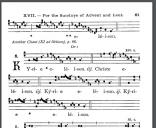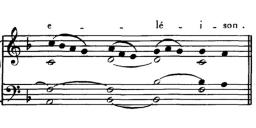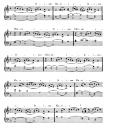Mass XVII in modern notation
-
I looked for an acceptable version of Mass XVII in modern notation, but they were all kind of janky, so I made my own on Finale. Took way too long, so now I am a little obsessed with my own work. Thus, I would appreciate any feedback you have, specifically on:
1) ease of reading, esp. for chant newbs
2) faithfulness to the original
3) the key I chose, the line breaks, etc.
~Ben Blackhawk, Mpls. MN -
Good job; I hope this will encourage others to make materials for congregational use.
-
One gets faster at these with practice! Repeat instructions might look better above the staff. The combination of eighth rests with stemless notes is novel to me but shouldn't cause problems, though I can't see a reason for them unless there's accompaniment. Instead of having individual tenuto marks doing the work of a single episema I would have put a poco rall above "gloria tua".
-
If you hope to be “faithful” to the solemnes method, consider (le -, e-i, son) with three groups of two at the end of the lines in the Kyrie
-
francis - No, Kyrie XVII(C) is an exception to the standard pattern. GR p.765
I wonder why there are three different settings of the Kyrie for this Mass. -
It's one of the few (and I can count them on one hand) times I've seen chant in modern notation that looked good. Great job!
-
AF.. please post references (pdf or jpg) to support your findings... in the end, it is really not worth squabbling over particulars... if they are singing THE CHANT... schools of thought are irrelevant (as I have said repeatedly on various threads)
... hearts in prayer with voices repeating what the saints have always held primary are truly the point.
So, BRAVO for the effort, GEOMERTICUS -
Not my opinion, just what Solesmes printed in 1961, and the OF GR is the same. I agree, I was not wanting to squabble, certainly not worth it. But just pointing out that the transcription into modern notation (ugh!) is accurate .

 LU1961.jpg428 x 352 - 53KThanked by 1tomjaw
LU1961.jpg428 x 352 - 53KThanked by 1tomjaw -
@a_f_hawkins
I think the problem is the modern books, in the old books you would have the two Kyrie for Lent and Advent, we sing the first one during Lent and the second in Advent. In the older books an older version of the first Kyrie is printed in the ad libitum section. Just as there is a simplified and older version of the Kyrie XI Orbis Factor, in the ad lib. section. The modern books give the 3 Lent / Advent kyrie all together as A,B and C. -
Since we are discussing Missa XVII, here's the pew card (letter, double-sided) that I designed for our church. You're free to share and print as many as you need. I'm also happy to send anyone individual movements as independent image files if needed.
(and FWIW, I suggest doing the Sanctus down in d or even c; it's notated in Eb to keep it in the staff and match the Agnus Dei (which, while high, can't really go lower) but the Sanctus can be a bit of a stretch for some)
 Missa XVII ADVENT • Landscape 2-up • GENERIC.pdf159K
Missa XVII ADVENT • Landscape 2-up • GENERIC.pdf159K -
Thanked by 1ServiamScores
-
just realized that the NOH might be a good reference...

 Screen Shot 2021-12-05 at 8.46.48 PM.jpg820 x 360 - 57K
Screen Shot 2021-12-05 at 8.46.48 PM.jpg820 x 360 - 57K
 Screen Shot 2021-12-05 at 8.46.38 PM.jpg1532 x 1730 - 478K
Screen Shot 2021-12-05 at 8.46.38 PM.jpg1532 x 1730 - 478K
 Screen Shot 2021-12-05 at 8.46.25 PM.jpg1424 x 346 - 96K
Screen Shot 2021-12-05 at 8.46.25 PM.jpg1424 x 346 - 96K -
Speaking for myself, since this was a pew card, I went for the simplest presentation possible, hence single slurs (that either sit on top when ascending or hang below when descending—a subtle cue for weak readers) to make it as simple as possible to process by PiPs. The situation is certainly different for choirs or trained musicians, however, in which case I always follow the original neume groupings just as NOH does.
(In my initial draft I had actually included the sub-groupings but decided it made things too cluttered.) -
In the USA, when you write a syllable over several notes you'll customarily use BOTH a dash and a slur/underscore. At least, it's a fact that vocalists are used to having the slur to help them visually make out these melismas.
Using the slur with vocal music for another purpose (marking out neume groups) sends a mixed message to the reader. -
Using the slur with vocal music for another purpose (marking out neume groups) sends a mixed message to the reader.
I don't know. I think it depends on the context. I appreciate knowing neume groupings, personally, but I read the original chant, so I know what the smaller slurs are intended to convey. They can also help you determine where emphases go in a long string of notes.
I think it also depends on which style of transcribing you're doing. I can think of a few general trends:
1a. – as literal as possible, honoring solesmes marking, using black dotted notes and squiggles to indicate the middle notes of certain neumes, etc.
1b. - as literal as possible, but no emphases, no dots, nothing. pure black dots à la vatican edition. figure it out yourself.
2. – mostly literal, but this time with black for "short" and white for "long" (this is what I favor for inexperienced chanters and PiPs).
3. - stemmed notation, be it quarters/halves, or eight notes beamed in groupings (the latter being particularly favored with some; I myself find it very difficult to read).
Options 1&2 can be presented either with slurs, or with very tight note groupings à la ICEL. While I like the look of the way icel does it for the missal, it is very finicky to set. Some people imitate this look loosely, but it looks very odd when you have tight neume groupings (no slurs needed) but then huge gaps between the words.
It's ultimately all a system of pros/cons. -
Here are a couple more:
1. Solesmes, as many of you may know, published a Liber Usualis in modern notation in 1924. I pulled their renditions of Mass XVII (from PDF-page 63 of vol. 1 of the scans) and placed them onto a single sheet.
2. I've also attached a page with my own Finale engravings of these chants, which I've used in congregational music sheets.
Even whilst employing something as standardized as modern musical notation, we still come up with varying solutions to the problem of chant transcription.
 MassXVII_modern_Solesmes.pdf1M
MassXVII_modern_Solesmes.pdf1M
 MassXVII_modern_Finale.pdf777KThanked by 1Liam
MassXVII_modern_Finale.pdf777KThanked by 1Liam -
CGM
I like your treatment of the horizontal episma over three neumes as dotted eighth notes. -
I've never been convinced by the first episema in the Sanctus, and the dotted quarter can only encourage "Heaven and earth are full. (of your glory)". This is a little closer to the way I sing it:

 PlenisuntXVII.pdf16K
PlenisuntXVII.pdf16K -
Richard
Yes, more mathematically accurate, but perhaps using all eighth notes might more closely reflect the chant notation? (Punctum and dotted punctum) -
Francis,
Just digressing about a treacherous phrase, and I don't actually advocate transcribing a congregational aide in triplets. As I said earlier, the equivalent of a 3-note episema would be quavers with (poco) rall.Thanked by 1francis -
This is my transcription (based on that of Solesmes) with chords.

 Missa_XVII_Kyrie_II.pdf44K
Missa_XVII_Kyrie_II.pdf44K
 Missa_XVII_Sanctus.pdf45K
Missa_XVII_Sanctus.pdf45K
 Missa_XVII_Agnus_Dei.pdf42K
Missa_XVII_Agnus_Dei.pdf42K
 Missa_XVII_Ite_Missa.pdf34K
Missa_XVII_Ite_Missa.pdf34K -
For two or three note horizontal episemes, I use the "lines" option in MuseScore. I imagine that in Finale it must be similar.
Here you can see my tutorial to transcribe Gregorian chant to modern notation in MuseScore (pdf).
 Eng_Gregorian_chant_in_MuseScore.pdf8M
Eng_Gregorian_chant_in_MuseScore.pdf8M -
I have found that the Solesmes way (and that of Juan Andrés') of notating chant in modern notation much more intuitive and easier to sing than other forms like the soprano notes in NOH (and Geometricus' version). Using quavers is more faithful to the pace of chant, and joining their tails together (beaming) on the melismatic syllable, rather than using slurs, is visually easier to understand for the non-musician.Thanked by 1Richard Mix
Welcome to the MusicaSacra Forum!
To participate in the discussions on Catholic church music, sign in or register as a forum member, The forum is a project of the Church Music Association of America.
Categories
- All Discussions21,157
- General Music Discussion8,236
- Job Openings204
- Management of Music Programs850
- Choral Matters533
- Church Documents and Rubrics526
- CMAA Notes303
- Events720
- For Newcomers: Read First26
- Sacred Polyphony547
- Hymnody872
- Gregorian Chant: General2,702
- ↳ Graduale Romanum and Liber Usualis368
- ↳ Graduale Simplex60
- ↳ Semiology63
- Vernacular Plainsong696
- Anglican Use and Anglican Chant68
- Organ, Other Instruments and Repertoire435
- New Composition/Works in Progress1,295
- Recordings234
- Music for Hispanic Ministry159
- Music Education: Children211
- Music Education: General222
- News Items245
- Positions Wanted2
- General Discussion: Catholicism740
- Amusements177
- General Discussion1,035
- Opinions119



